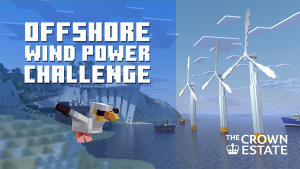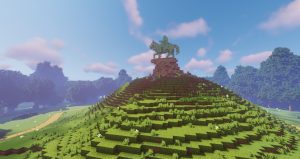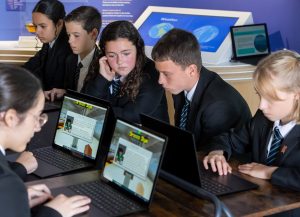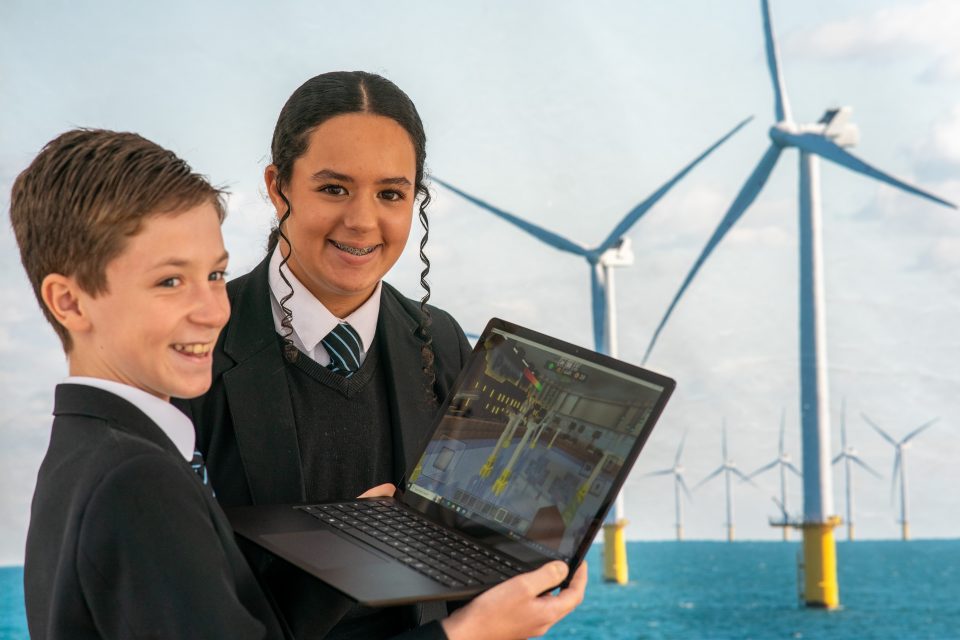Seven miles off the coast of Brighton, the blades of 116 wind turbines gracefully rotate in the September breeze. The turbines make up Rampion Wind Farm, and the energy they generate powers up to 350,000 UK homes annually.
Meanwhile, onshore, a class of Year 8 students from Peacehaven Community School are discovering more about wind powered energy at Rampion Visitor Centre – and they’re using Minecraft to bring their own wind farms to life.
It’s all part of a new sustainability initiative launched by The Crown Estate, in collaboration with Microsoft. Two new Minecraft Education worlds, one in Windsor Great Park and the other at an offshore wind farm, are encouraging students to develop green skills, explore wind farm planning, marine conservation, and ecology.
“We’ve developed two worlds, and while the locations are different, they overlap in many respects because they’re about the environment,” explains Judith Everett, Executive Director of Purpose, Sustainability and Stakeholder for The Crown Estate. “The core goal is to get students thinking about ‘how do we develop and continue using and appreciating spaces without causing damage to the environment?’.”
The Crown Estate, Minecraft and sustainability: A dream project
The Crown Estate approached the Minecraft team with clear learning objectives, recognising the game’s ability to immerse children in the stories and the narratives that they were trying to tell. Justin Edwards, Director of Learning Experiences for Minecraft Education, hails it as “a dream project”.
“Minecraft is uniquely positioned to connect children to the topic,” acknowledges Edwards. “The game is almost 15 years old, and people are familiar with the blocky structure of it. The open sandbox allows you to create anything you want, so whether it’s building a wind farm or even connecting people to world peace, you can achieve that in Minecraft because it’s completely adaptable. And moreover, it’s fun; Minecraft brings an enjoyable play experience to serious and important content.”

During the lesson at Rampion Visitors Centre, it was the students’ focus that spoke volumes. “The students were so engrossed that there was total silence in the room,” observes Edwards. “To hear the educator, Tracy, asking questions at the end and for the students to repeat back confidently the learning, you know that it learning has stuck and they’ve also enjoyed the experience. That’s what educators want – children to learn and have fun.”
Managers of the seabed
Rampion is one of the 50 active wind farms built on the seabed around the UK coast. The Crown Estate is a national landowner that manages the seabed around England, Wales and Northern Ireland, and therefore manages the rights to renewable energy generation at sea, including wind farms, tidal, and wave energy projects. Considerations such as water depth, environmental designations, and impact on shipping lanes are part of the wind farm selection process.
“You start to take out all the areas where you can’t develop, then look at the areas that are most suitable,” Everett explains. “Then it’s a case of understanding what the wind resource is like, and then you go through the public consenting process.” These processes are a key part of the Minecraft Offshore Wind Power Challenge, gamifying the wind farm development process for students, from exploration to operation, involving various disciplines.
Minecraft gamification to inspire younger audiences
It’s not just wind farms getting the block treatment; Windsor Great Park also features. With a history stretching back over a millennium, it’s home to thousands of species of wildlife spanning approximately 4,500 acres.

The park has a long-standing commitment to sustainability, and students have a unique opportunity to manage its ecological health. By completing a series of quests, they can learn about the water cycle, the aquatic food chain, conservation, and environmental management. “Gamification has a huge role to play in education and it makes the topics much more accessible,” adds Everett.
Tracy Urch agrees. As a teacher and consultant with the social impact agency, Hopscotch, she facilitated the lesson for the Peacehaven students at Rampion. “Minecraft is a great engaging tool to grab young people’s attention; as soon as we mentioned Minecraft to the students, their eyes lit up.”
“Sustainability as a subject can be made to seem difficult but it’s all about breaking it down for young people and making it accessible,” Urch adds. “For students to effectively engage in a Minecraft world requires logic, interaction, problem solving and decision, so it’s a really useful way to use technology and learn about the topic.”
Offshore wind: Lessons learned in Minecraft
For Judith Everett, the best scenario would be for the initiative to raise awareness about sustainability among young people and their parents alike. “For young people who are exploring the world to potentially go on to work in those areas, or just be better informed in terms of what’s happening in the environment around us, would be ideal,” says Everett.
And for students whose interest has been piqued by the Minecraft challenges, Everett namechecks multiple career routes, from marine scientists, to meteorologists, engineers, installation maintenance, and biodiversity to name a few.

Oliver, Maya, Ellis and Monique were four of the students who attended the session, and they all took different learnings away with them.
For Oliver, it was designing wind farms and finding out how much energy they need to power the neighbourhood; Maya discovered there are types of wind farms that can float on water. And while Monique loved how Minecraft brought the marine sea creatures the life, for her the best bit was “finding out about how it all works and the lots of different jobs that you can do.” For Ellis, it was the engineering element; “Before today we thought there was just one type of turbine, but there’s actually three different ones.”
“To be honest, I’ve always been really interested in saving the planet but until now I’ve never really thought about how wind farms could help,” said Ellis. “But now it’s changed my mind… there are many more ways to help with climate change than I thought.”
Find out more:
Visit Minecraft Education to download the free games, teacher packs and resources from The Crown Estate collaboration.






